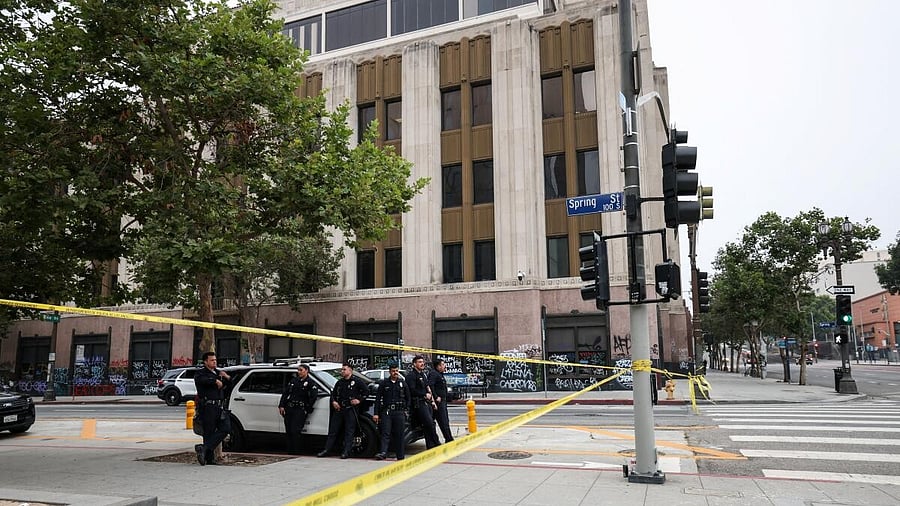
Members of law enforcement stand next to a police car, in Los Angeles.
Credit: Reuters photo
The mayor of Los Angeles announced a nighttime curfew in the downtown area Tuesday to calm unrest after days of demonstrations against President Donald Trump's immigration policies, as the demonstrations spread to other U.S. cities.
Anger is widening over federal workplace immigration raids as well as the federal response to the demonstrations, after the Trump administration deployed the Marines and National Guard troops to Los Angeles -- a rare use of active-duty military forces on US soil.
Trump mobilized the troops in a mission that officials said was intended to protect federal property and agents, doing so over the strong objections of officials in California and Los Angeles.
Though many of the demonstrations have been peaceful, clashes between law enforcement officers and demonstrators have led to hundreds of arrests in the Los Angeles area since Friday. Local law enforcement officers have fired munitions that left protesters and journalists injured.
How did the protests develop?
Protests broke out Friday when federal agents searched the garment district in Los Angeles, the second-largest U.S. city, for workers whom they suspected of being in the country illegally, as part of the Trump administration's new focus on raiding workplaces.
The agents were met by protesters who chanted and threw eggs before being dispersed by law enforcement officers with pepper spray and nonlethal bullets.
Demonstrations continued Saturday, both downtown and in the mostly Latino and working-class suburb of Paramount, about 15 miles south. Law enforcement officers made arrests and in some cases used crowd-control munitions like tear gas and flash-bang grenades against the protesters.
On Sunday, as nearly 300 members of the California National Guard took positions in the city on Trump's orders, demonstrations near a downtown detention center were largely peaceful. But some protesters shot fireworks at police officers under a freeway overpass nearby, and several driverless Waymo cars were set on fire.
How are the National Guard and Marines involved?
Trump signed a memo Saturday ordering 2,000 National Guard members to deploy to Los Angeles to protect federal officers conducting immigration raids, despite the objections of California officials, who said that local law enforcement agencies were in control of the situation.
Two days later, even as protests in Los Angeles remained relatively confined, Trump doubled the number of deployed California Guard troops to 4,000 and mobilized a battalion of 700 Marines to the city.
On Tuesday, armed National Guard troops joined federal immigration enforcement officers during raids in Los Angeles, a move the state of California has called unlawful and inflammatory.
The National Guard is the only branch of the military that can be deployed both by state governors and by the president. Governors nearly always control deployment in their states. Most Guard members hold civilian jobs and do not serve full time, but are called into active service occasionally, most often during natural disasters like hurricanes, floods and wildfires.
The last time a president activated a state's National Guard troops for such a purpose without being asked by the governor was in 1965, when President Lyndon B. Johnson used troops to protect civil rights demonstrators in Alabama.
Late Tuesday, Gov. Greg Abbott of Texas became the first governor to announce that he would call in the National Guard in response to the demonstrations, as protests in solidarity with those in Los Angeles took place in multiple Texas cities.
How does the LA curfew work?
After episodes of looting and vandalism downtown led to about 200 arrests Tuesday, the most in a single day since the protests began, Mayor Karen Bass of Los Angeles announced a nighttime curfew in the area that she said would likely be in place for several days.
Throughout the protests, the mayor has said the unrest in Los Angeles is not widespread, and she emphasized Tuesday that the area under curfew was around 1 square mile in a city of around 500 square miles.
The curfew does not apply to residents of the area, homeless people, members of the news media or public safety personnel, and is intended to prevent scattered episodes of looting and damage to businesses, she said.
What is the Trump administration's rationale for deploying troops?
Trump has cast the protesters in Los Angeles as "insurrectionists" and has said he would "liberate" the city, appearing to adopt a rationale that could allow him to invoke the 1807 Insurrection Act and use active-duty U.S. military personnel to deal with protests.
California Gov. Gavin Newsom, a Democrat, made a nationally televised address Tuesday in which he said that by sending in troops, Trump had committed a "brazen abuse of power" and "inflamed a combustible situation." He urged Americans to stand up to the president, calling it a "perilous moment" for democracy.
The state of California has sued the Trump administration, challenging the military mobilization as an unlawful commandeering of state power. Newsom also filed an emergency motion in federal court asking that Marines and National Guard troops only be allowed to guard federal buildings. A federal judge in California scheduled a hearing on that request for Thursday.
Are the protests spreading?
Protests over the immigration raids grew in size and intensity across the United States on Tuesday.
Some demonstrators in downtown Chicago threw water bottles at police officers and vandalized at least two vehicles. In New York, officers made dozens of arrests near federal buildings in lower Manhattan, police said. In Atlanta, police used chemical agents and physical force to drive a few dozen protesters from a highway.
More demonstrations were planned in several cities Wednesday, including San Antonio, Seattle, St. Louis and Raleigh, North Carolina. Some organizers said the demonstrations this week were a prelude to larger protests planned for Saturday against Trump and a rare military parade in Washington, DC, being held that day.